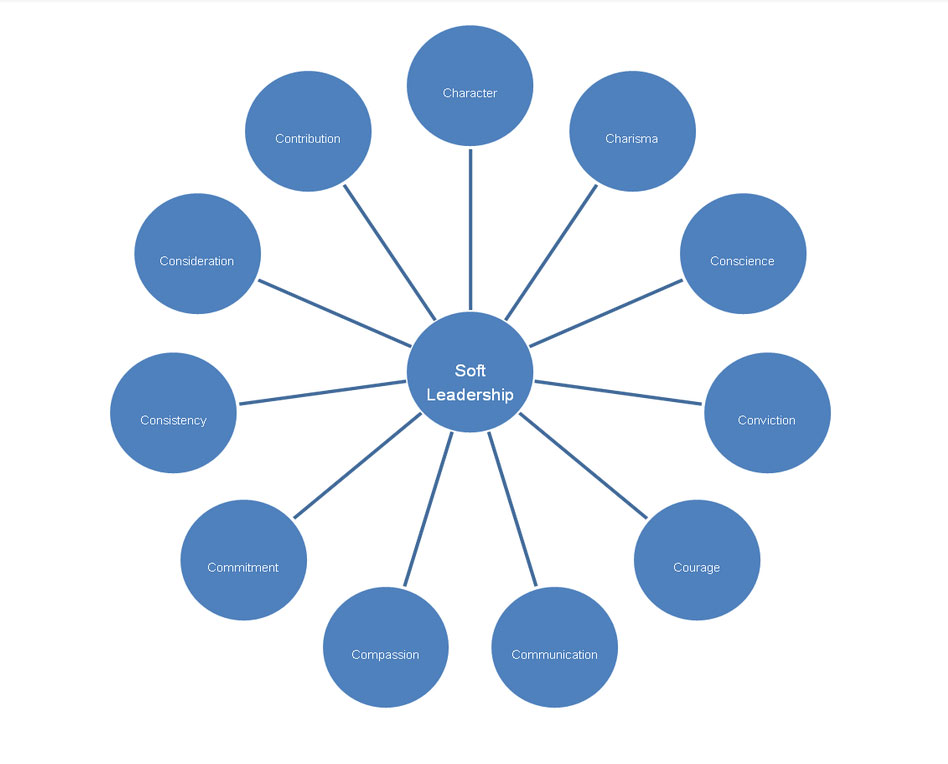Exploring Soft Leadership In The Post-Coronavirus World

“Soft leadership can be defined as the process of setting goals; influencing people through persuasion; building strong teams; negotiating them with a win-win attitude; respecting their failures; handholding them; motivating them constantly; aligning their energies and efforts; recognizing and appreciating their contribution in accomplishing organizational goals and objectives with an emphasis on soft skills. It is based on the right mindset, skillset, and toolset.” ―Professor M.S. Rao
Presently people across the globe are getting impatient, intolerant, and agitated on others for petty issues. It appears to be a lack of respect toward others’ religions, regions, races, languages, ethnicities, cultures, and communities. Additionally, the aspirations and expectations of all stakeholders are rising rapidly. For instance, children demand more from their parents; students demand more from educators; subordinates demand more from superiors; employees demand more from employers; followers demand more from leaders; people demand more from nations. People are becoming more rights-oriented rather than duty-oriented.
There must be a shift in the mindset of the people. There must be a need for tolerance and respect toward others. People must be duty-oriented rather than rights-oriented. Empathy is the answer to several pressing global challenges. Empathy is the ability to step into the shoes of others and look at the issues from others’ perspectives. However, presently people rarely empathize with others. When we empathize with others most of the global challenges and conflicts can be resolved easily. Through empathy, we can put an end to intolerance, impatience, and instability. Through empathy, we can resolve several global challenges amicably. Empathy is essential for global peace, prosperity, stability, and security.
What Is Soft Leadership?
When you look at leaders including Booker T. Washington, Benjamin Franklin, Mahatma Gandhi, Martin Luther King, Mother Teresa, Mikhail Gorbachev, Dalai Lama, and Aung San Sui Kyi, there is a common thread connecting all of them―soft leadership.
Soft leadership is leading through soft skills and people skills. It blends soft skills, hard skills, and leadership. It emphasizes the significance of precious human resources. It helps in managing the emotions, egos, and feelings of the people successfully. It focuses on the personality, attitude, and behavior of the people, and calls for making others feel more important. It is an integrative, participative, relationship, and behavioral leadership model adopting tools such as persuasion, negotiation, recognition, appreciation, motivation, and collaboration to accomplish the tasks effectively.
Soft leadership is not a submissive leadership or a lame-duck leadership but an assertive leadership where soft leaders adopt pleasing and polite communication to execute the tasks effectively. It is a blend of courageous leadership, thought leadership, servant leadership, and inspirational leadership. Succinctly, soft leadership can be defined as the process of setting goals; influencing people through persuasion; building strong teams; negotiating them with a win-win attitude; respecting their failures; handholding them; motivating them constantly; aligning their energies and efforts; recognizing and appreciating their contribution in accomplishing organizational goals and objectives with an emphasis on soft skills. It is based on the right mindset, skillset, and toolset.
Leadership depends on three aspects—how you communicate with others; how you make decisions; and how you take action. When you can execute these three activities effectively you become a successful leader. However, to evolve as a soft leader, you must communicate with an emphasis on soft skills; make decisions by blending your head, heart, and gut; and take action keeping the ground realities and goals in your view without compromising task-orientation. There are 11 Cs that constitute soft leadership. They are character, charisma, conscience, conviction, courage, communication, compassion, commitment, consistency, consideration, and contribution. It is highly challenging for people to cultivate these 11 characteristics. However, if people possess more than 6 traits they get into the fold of soft leadership. Here is the diagram connecting 11 C’s that collectively constitute soft leadership.

Soft Leadership In The Post-Coronavirus World
Soft leadership is the best fit in the post-coronavirus world. It helps lead knowledge workers effectively. Previously more manual workers needed various leadership styles. However, in the present rapidly changing digital scenario, the knowledge workers need a different leadership style—soft leadership style. The knowledge workers are ambitious, intelligent, and tech-savvy. They have different expectations and aspirations than their predecessors. They have an advanced mindset, toolset, and skillset gained through unique professional experiences. And soft leadership is the ideal fit for their needs.
Currently, the employees are more diverse than ever, and this offers both opportunities and threats. Opportunities include creativity and innovation to improve products and services; and threats include looking at differences, not similarities. Hence, we must convert this threat into an opportunity by celebrating diversity in the workplace. It also calls for a unique leadership style that brings employees into one common platform to achieve the organizational goals and objectives.
Globally the philosophy of ‘employees first, customers second, and shareholders third’ is gaining momentum. Keeping this philosophy in view, global organizations need leaders who can navigate their organizations through a network of relationships. Presently the days of positional power work less and referent power works more. Above all, global organizations must be networked, flat, flexible, and diverse. Hence, soft leadership can work for any company and country regardless of its size or budget.
The days of command-and-control leadership don’t work anymore. What works presently is trust-and-track leadership. As the world is changing rapidly, the knowledge, skills, and abilities essential for employees are changing rapidly. The employees are reinventing themselves to keep pace with the rapid changes in technologies. Additionally, they are more focused on their careers and are ready to sacrifice their families to fast-track their careers. Their expectations and aspirations are rising. Hence, leaders at the top must reinvent their leadership styles, tools, and techniques to lead their employees in this digital age. So, exploring soft leadership helps greatly for the leaders to satisfy all stakeholders to achieve organizational excellence and effectiveness.
Explore Soft Leadership To Achieve Global Peace And Prosperity
Starting a war is easy but nobody knows when it ends, where it ends, and how it ends. However, we can imagine the damage and suffering that causes humanity. Hence, war is not the solution to all problems. Many people die and there is a loss to nations. It brings agony to the people and takes the nations backward by many years. We have seen how many years it took for Germany and Japan to recover from the Second World War. To summarize, conflicts must be resolved amicably through discussion and dialogue. It is essential to adopt soft leadership during the dialogue and discussion to achieve global stability, peace, and prosperity.
Written by Professor M.S. Rao.
Bring the best of the CEOWORLD magazine's global journalism to audiences in the United States and around the world. - Add CEOWORLD magazine to your Google News feed.
Follow CEOWORLD magazine headlines on: Google News, LinkedIn, Twitter, and Facebook.
Copyright 2025 The CEOWORLD magazine. All rights reserved. This material (and any extract from it) must not be copied, redistributed or placed on any website, without CEOWORLD magazine' prior written consent. For media queries, please contact: info@ceoworld.biz








